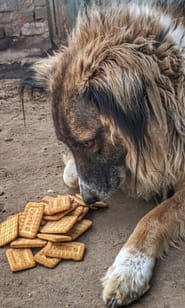Mange in Dogs: Why Your Dog Keeps Licking Its Paws — Redness & Black Lesions Explained

Quick summary: Mange is a skin disease caused by microscopic mites. If your dog is constantly licking its paws, or you see redness, thickening or dark (black) lesions on the paw pads or between the toes, mange could be the cause — or a secondary infection driven by the itching. Don’t panic: most cases are treatable when diagnosed promptly.
What is mange?
Mange is caused by tiny mites that live in the skin or hair follicles. Two types are most relevant in dogs:
- Sarcoptic mange (scabies): highly contagious and very itchy.
- Demodectic mange (demodicosis): usually related to immune status; may be localized or generalized.

Paw licking — why it matters
Excessive paw licking is a very common early sign. Mites often concentrate between the toes, producing intense irritation. The repeated licking and chewing damages the skin barrier and sets up secondary infections (bacterial or yeast), which in turn cause more licking — a vicious cycle.

Redness, black lesions and what they mean
As the problem progresses you may notice:
- Bright redness between toes or on paw pads
- Scaling, crusting or hair loss at the margins of the paw
- Dark (black) lesions or hyperpigmentation from chronic inflammation or post-inflammatory changes
- Oozing or a greasy discharge when secondary infection is present
How a vet diagnoses mange
Your veterinarian will typically perform:
- Superficial skin scrapings examined under microscope (to identify mites)
- Hair plucks and cytology to check for bacteria/yeast
- In stubborn cases, fungal cultures or skin biopsy
Treatment options
Treatment is tailored to the type of mange and whether secondary infections exist. Typical approaches include:
- Topical therapies: medicated shampoos, dips (amitraz, benzoyl peroxide) and spot-on products
- Systemic treatments: oral or injectable parasiticides (ivermectin in selected cases, or modern isoxazolines such as fluralaner or afoxolaner when appropriate)
- Antibiotics/antifungals for secondary infections
- Supportive care: paw cleaning, wound care, and nutrition

Home care and prevention
- Keep bedding clean and dry; wash in hot water.
- Treat all in-contact dogs if mange is suspected.
- Don’t use household chemicals or folk remedies on open skin.
- Maintain a balanced diet and address stressors that can suppress immunity.
- Regularly check paws for early redness or scabs.
When to see the vet — urgency guide
- Same day: heavy bleeding, widespread oozing, fever, or your dog is lethargic.
- Within 48 hours: rapid spreading redness, severe licking causing sores, or multiple dogs affected in the house.
- Routine: mild single-area redness or slight increase in paw licking.

Printable checklist for owners
- Observe: how often is my dog licking? (times/day)
- Inspect: redness, scaling, black spots — take photos
- Hygiene: wash bedding, keep paws dry
- Note: any other sick dogs or recent contact with strays

Dr. Suranjan Sarkar is a veterinarian and also a writer and editor for both print and digital with a love for travel, animal, and architecture. Much of his writing has focused on human and animal health and welfare. A life-long pet owner, His two favorite canine quotes are, “Be the kind of person your dog thinks you are,” and “Dogs communicate their feelings honestly and directly. There’s no hidden agenda or manipulation.”








